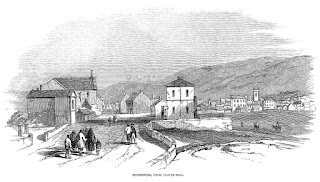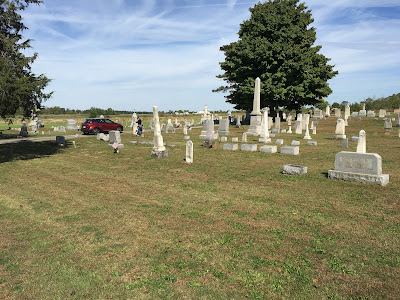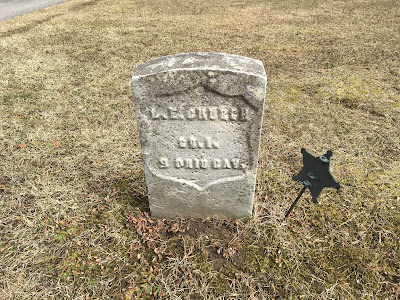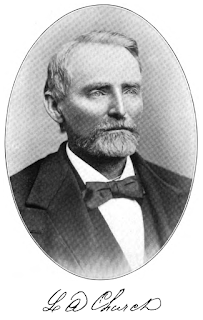To quickly recap: I’ve already written about three ancestors who emigrated from West Cork. These were my great great grandmother, Ellen (Collins) Driscoll, her daughter Hannah, and her brother, Peter Collins. It turns out, though, that they were only the tip of the iceberg. The story of the Driscolls and Collins in the U.S. has really expanded thanks to DNA tests. As I tried to understand and reconcile some mysterious close DNA matches, I found out just how little I knew.
This story begins with a DNA match with my mother, a match that Ancestry.com estimated was a 4th to 6th cousin (a total of 41 centimorgans of shared DNA over three segments). That was enough to get my attention, and my interest was further piqued by the family tree this user had: the father and paternal grandfather of the person whose DNA this was were named Collins. So I explored a little further.
The grandfather’s name was Thomas J. Collins, and his son, also named Thomas, was born and died in Norwich, New York. (A warning: we're going to encounter a number of people named Thomas Collins. To help keep them straight, I'll give them nicknames. For reasons that will be clear soon, I'll refer to the first one, Thomas J. Collins, as Engineer Tom.) The fact that Engineer Tom lived in New York State led me to explore that combination of name and place in the website fultonhistory.com. I’m not sure if I’ve already described this website before, but this is an admirable one-man operation run by Tom Tryniski out of Fulton, New York, just south of Oswego. He’s been digitizing, databasing, and providing free on-line access to historical newspapers, originally mostly in New York State, but lately expanding ot other areas. According to the website, there are now over 49.5 million pages available on-line. Being from Fulton, it’s not surprising that there are extensive records for the papers from central New York.
As I rummaged through the fultonhistory.com resource I was surprised to find that an obituary for Engineer Tom was published in The Oswego Daily Palladium on 17 May 1916. Like his son, Engineer Tom also died in Norwich, but the obituary reported that he was a former resident of Oswego. Now the combination of Collins, Oswego, and the DNA match really had my attention, and I ended up researching this line for months. One other thing in the obituary was notable. In addition to the typical regrets were these sentences:
He was a patriotic citizen, a useful member of society, a loving husband and devoted father, and a delightful companion who faithfully discharged every duty and obligation. Seldom has the death of any one brought keener sorrow to so many hearts. There was no one along the O. & W. lines or among those with whom he came in contact that was not his friend.
Another death notice published in the Middletown Times-Press noted that Engineer Tom was “a well known locomotive engineer on the O. & W.” The O&W began its life as the New York and Oswego Midland Rail Road, the brainchild of Dewitt C. Littlejohn (1818-1892). Construction began in 1868 for a line that would run from Cornwall, New York (on the Hudson River) northwest to Fulton, with a branch to Utica. I was fascinated to learn that the funds to build the railroad came largely from the towns along its route, a kind of pay-to-play scheme. As a result, the road was long and winding and included some steep grades and deep cuts. The scale of these construction costs forced the company into bankruptcy within a month of the actual completion of construction. The company was then reorganized in 1880 under the name of the New York, Ontario & Western Railway, or the O&W.

The relationship of the O&W with other railroad companies was complicated: the owners were also involved in other companies, rail lines were shared between rivals, and the many original small companies were being gobbled up by the big conglomerates. This was the heyday of Corrnelius Vanderbilt and the New York Central Railroad. Vanderbilt started out owning companies in the New York City area, expanded northward through the Hudson Valley, and then his acquisitions turned toward the west to Buffalo and beyond. The O&W also expanded its own lines, sharing track with the New York Central from Fulton to the port in Oswego and also opening a terminal in Weehawken, New Jersey, just where the Lincoln Tunnel is today.
The main businesses of the O&W were carrying passengers, mainly tourists going from the City to the resorts in the lower Catskills; hauling milk and other dairy; and eventually getting deep into the transport of coal out of the fields in northeastern Pennsylvania. One of my sources said that by the early 1930s coal accounted for 50% of the O&W business. By that time the company also owned three collieries, an early 20th century example of vertical integration. Unfortunately, this turned out to be a fraught financial decision. Two of the coal companies defaulted on their loans from the O&W, forcing the railroad in turn to default on its own mortgages. The O&W eventually declared bankruptcy (again) and the last train ran in 1957.
Very little of the physical footprint of the O&W remains: a few abandoned railroad tunnels, very little track, and some depots. The Oswego County Recreational Trail follows the old route of the railroad, and the Harbor Rail Trail in the city of Oswego makes use of the old railroad bridge across the river. There is still a good deal of interest in the railroad: the Ontario & Western Railway Historical Society is “dedicated to preserving the heritage of the New York Ontario & Western and other area railways.” They are involved in numerous restoration projects, maintain the company archives (600 cubic feet of records – five tons!), publish a newsletter, calendar, sponsor talks, etc.
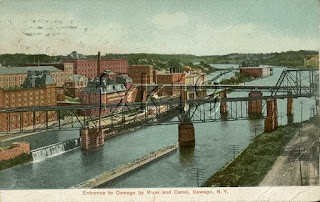
Thomas J. Collins (1867-1916), my Engineer Tom, pictured at left, was promoted to engineer on 20 Feb 1892. Together with George W. Obenauer he founded the Lyon Brook Lodge #216 of the Brotherhood of Locomotive Firemen and Enginemen. Engineer Tom’s son, Tom, married Betty Ann Fagan in 1943. Both her father, John Edward Fagan (1887-1972), and his father before him, John Fagan (1854-1919), were also engineers working for the O&W. The picture at the beginning of this post shows John Fagan, on the left, with his conductor. The long family history of engineers – in total there were seven of them – was the subject of a photo-story by John Taibi, “Fagan, Batie, Colllins, & King – A family that spanned a railroad’s life.” It has quite a few historical photographs of the engineers and their engines.
Let’s retrace our steps here. I have a DNA match with a grandson of Engineer Tom, and the latter died in Norwich, but was born in Oswego. Engineer Tom was the son of John Collins and Julia (Johanna) Burns. I’m not sure about the details of her name: both are found in the records I’ve uncovered. John was born in 1846, as was Julia. John arrived in the U.S. somewhere around 1863-1864 at the age of 18, and he initially worked on the lumber docks in Oswego. Eventually, he became a coal dealer. It was this profession that made it possible for me to recognize this particular John Collins among the other men by the same name living in Oswego around the turn of the 20th century.
John Collins died sometime late in the night of New Year’s Eve or in the early morning of New Year's Day in 1917. If you check back, you’ll see that his son, Engineer Tom, died earlier in 1916, on 14 May 1916. But as John’s obituary noted, there was a third death in the family that year. Julia, John’s wife and Engineer Tom’s mother, passed on 26 April 1916. A short notice in the Oswego Daily Palladium on the 24th of January of that year reported that she was critically ill at her home on 120 East Tenth Street. It was later recorded that she had been in ill health for some time and was “very much depressed.” Sometime around 3 a.m. on April 26 members of the family reported hearing her moving about the house, going from one room to another. When they got up to check on her, she had apparently gone back to sleep. But shortly before 6 a.m. they discovered that she was missing, and her son Peter and daughter Mary began a search. The newspaper reported that they eventually found her in the shallow waters of Lake Ontario, near St. Paul’s Cemetery, roughly a mile away from home (as the crow flies). The house itself is only about 4-5 blocks away from the lake, and perhaps the current moved her northeast toward the cemetery. It doesn't record whether she was in her nightclothes or properly dressed. The most that I could find about the weather at the time was that it was predicted to be cloudy and cool in Oswego; in Buffalo the temperature range for that day was 46°-52° F. I imagine that it was pretty nippy at dawn on the lake shore in Oswego in late April.
The exact relationship of John Collins was confirmed in his obituary, which closed with the words “He is survived by … one sister, Mrs. Ellen Driscoll [my 2nd great grandmother], and one brother, Peter Collins of this city.” To further support the relationship of John to my 2GG Ellen and her brother, my 3rd great uncle Peter, I obtained a copy of John’s death certificate from the office of the Oswego city clerk. On this it was recorded that his parents were Thomas Collins [3GG Tom] and Mary Gainey, the same names found for the parents of Ellen (on her baptismal record) and Peter (on both his baptismal and death records).
As I was uncovering these records and looking for newspaper articles to fill in details of the lives of John and Julia Collins, I came across this short notice published in the Oswego Daily Times on 23 Sep 1902:
John Collins, the East Side coal dealer, and his nephew, Peter Collins, have returned from a ten weeks’ visit to Ireland. They visited its principal cities including Dublin, Cork, Limerick and Belfast and report having a most enjoyable time.
A nephew Peter Collins? John had a son named Peter, but neither the Ellen nor the Peter that I knew had a son by that name. Who was this person? This was the door opening into yet another part of the family. Recall from my last blog post that the earliest U.S. record I have of my great grandmother, Hannah Driscoll, came from the 1892 New York census. There she was listed immediately after the entries for a Thomas Collins – yes, another Tom Collins – followed by a Peter and a Nellie Collins. This Thomas was then the sexton of St. Paul’s Cemetery, so I'll refer to him as Sexton Tom. His wife, Ann Burns, had died in 1889, and they had had five children. Two daughters, Mary and Catherine, died young, and, of course, there was a son named Thomas. Tom the Sexton's son died in 1888 at the age of 22 in a railroad accident. Sexton Tom died of a heart attack in 1894. By that time his his brother (I think) Peter had already come to Oswego from Ireland, but his sister, Ellen, would not arrive for another year or so. I’m hedging a little bit here: so far I’ve not found any DNA match with Sexton Tom’s descendants. However, and you won’t be surprised at this, 3GG Thomas Collins and Mary Geaney in Drishanebeg did have a son that they named Thomas who was born at about the same time as the sexton. Whether that Tom and Sexton Tom are one and the same seems very likely to me, but I’m still missing definitive evidence. Similarly, I am just so tempted to infer some relationship between the wives of Sexton Tom and John the coal merchant, both of whom had the surname Burns. I haven’t tracked that one down yet, but it is very intriguing.
So far, then, I have (I think) four Collins siblings in Oswego: Sexton Thomas, Peter, Ellen, and John. I went back to the baptismal records in Skibbereen parish in Ireland looking for additional children born to 3GG Thomas Collins and Mary Geany. Indeed, there were more: a son named Jeremiah who was born in 1826, and another son, Barry born in 1829. That means that the four children who moved to Oswego were the youngest of the family. I’m still trying to run Jeremiah and Barry to ground. It appears that they both stayed in Ireland on the old homestead in the townland of Drishanebeg. And I have found at least one DNA match with a descendant of Jeremiah. For what it’s worth, I think that it’s noteworthy that Sexton Tom’s son, Peter, had the middle name Barry, just like his putative uncle. I take that as some confirmation that I’m on the right track. There are lots of trails to follow still, but it looks very promising. I know that the similarity in names is probably confusing. By my count, in this post alone there are five different people named Tom Collins. That’s confusing for me as well, especially when a document only has the name and nothing else. One example of this is the death certificate of Sexton Tom. The danger of confirmation bias is also something that I try to be aware of, but I’m only human. I hope that, with enough pieces of evidence that fit together, we can try to cobble together a coherent picture.
- Taibi, J. Fagan, Batie, Collins, & King - a family that spanned a railroad's life. The Northern Division Bridge & Building Dept., No. 113. http://ontarioexpress.org/wp-content/uploads/2015/11/nd_FBCK.pdf
- Ontario & Western Railway Historical Society, Inc. http://nyow.org















